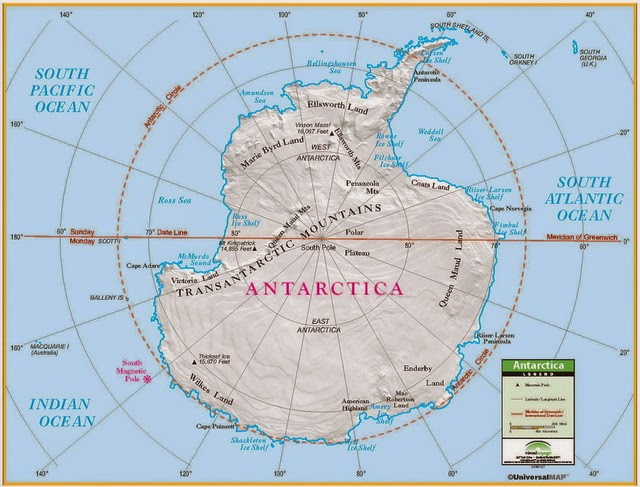The South Pole,
also known as the Geographic South Pole or Terrestrial South Pole, is one of
the two points where the Earth's axis of rotation intersects its surface. It is
the southernmost point on the surface of the Earth and lies on the opposite
side of the Earth from the North Pole.
Situated on the
continent of Antarctica, it is the site of the United States Amundsen-Scott
South Pole Station, which was established in 1956 and has been permanently
staffed since that year. The Geographic South Pole should not be confused with
the South Magnetic Pole, which is defined based on the Earth's magnetic field.
 Antarctica is
Earth's southernmost continent, containing the geographic South Pole. It is
situated in the Antarctic region of the Southern Hemisphere, almost entirely
south of the Antarctic Circle, and is surrounded by the Southern Ocean. At 14.0
million km2 (5.4 million sq mi), it is the fifth-largest continent in area
after Asia, Africa, North America, and South America. For comparison,
Antarctica is nearly twice the size of Australia. About 98% of Antarctica is
covered by ice that averages 1.9 kilometres (1.2 mi) in thickness, which extends
to all but the northernmost reaches of the Antarctic Peninsula.
Antarctica is
Earth's southernmost continent, containing the geographic South Pole. It is
situated in the Antarctic region of the Southern Hemisphere, almost entirely
south of the Antarctic Circle, and is surrounded by the Southern Ocean. At 14.0
million km2 (5.4 million sq mi), it is the fifth-largest continent in area
after Asia, Africa, North America, and South America. For comparison,
Antarctica is nearly twice the size of Australia. About 98% of Antarctica is
covered by ice that averages 1.9 kilometres (1.2 mi) in thickness, which extends
to all but the northernmost reaches of the Antarctic Peninsula.
Antarctica, on
average, is the coldest, driest, and windiest continent, and has the highest
average elevation of all the continents. Antarctica is considered a desert,
with annual precipitation of only 200 mm (8 inches) along the coast and far
less inland. The temperature in Antarctica has reached −89 °C (−129 °F). There
are no permanent human residents, but anywhere from 1,000 to 5,000 people
reside throughout the year at the research stations scattered across the
continent. Only cold-adapted organisms survive, including many types of algae,
bacteria, fungi, plants, protista, and certain animals, such as mites,
nematodes, penguins, seals and tardigrades. Vegetation where it occurs is tundra.
Although myths
and speculation about a Terra Australis ("Southern Land") date back
to antiquity, the Russian expedition of Fabian Gottlieb von Bellingshausen and
Mikhail Lazarev on Vostok and Mirny first sighted a continental ice shelf in
1820. The continent, however, remained largely neglected for the rest of the
19th century because of its hostile environment, lack of resources, and
isolation.
Antarctica is a
de facto condominium, governed by parties to the Antarctic Treaty System that
have consulting status. The Antarctic Treaty was signed in 1959 by 12
countries; to date, 50 countries have signed the treaty. The treaty prohibits
military activities and mineral mining, prohibits nuclear explosions and
nuclear waste disposal, supports scientific research, and protects the
continent's ecozone. Ongoing experiments are conducted by more than 4,000
scientists from many nations.
For most
purposes, the Geographic South Pole is defined as the southern point of the two
points where the Earth's axis of rotation intersects its surface (the other
being the Geographic North Pole). However, the Earth's axis of rotation is
actually subject to very small 'wobbles', so this definition is not adequate
for very precise work; see Polar Motion for further information.
The geographic coordinates
of the South Pole are usually given simply as 90°S, since its longitude is
geometrically undefined and irrelevant. When a longitude is desired, it may be
given as 0°. At the South Pole all directions face north. For this reason,
directions at the Pole are given relative to "grid north", which
points northwards along the prime meridian.
The Geographic
South Pole is located on the continent of Antarctica (although this has not
been the case for all of Earth's history because of continental drift). It sits
atop a featureless, barren, windswept, icy plateau at an altitude of 2,835
metres (9,301 ft) above sea level, and located about 1,300 km (800 mi) from the
nearest open sea at Bay of Whales. The ice is estimated to be about 2,700
metres (9,000 ft) thick at the Pole, so the land surface under the ice sheet is
actually near sea level.
The polar ice
sheet is moving at a rate of roughly 10 metres per year in a direction between
37° and 40° west of grid north, down towards the Weddell Sea. Therefore, the
position of the station and other artificial features relative to the
geographic pole gradually shifts over time.
The Geographic
South Pole is marked by a ceremony on New Year's Day in which a small sign and
American flag are moved, and newly revealed annual stake is placed in the ice
pack, which are positioned each year to compensate for the movement of the ice.
The sign records the respective dates that Roald Amundsen and Robert F. Scott
reached the Pole, followed by a short quotation from each man, and gives the
elevation as 2,835 metres (9,301 ft). The current stake has the position of the
planets, sun, and moon on January 1, as well as a copper star marking the pole.



No comments:
Post a Comment